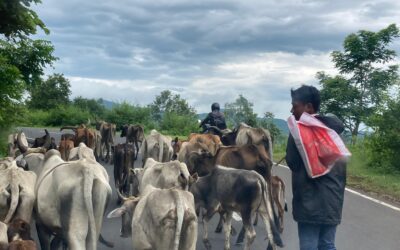As a part of training program at India fellow, I got an opportunity to visit the rural parts of Udaipur. The visit was intended merely for observing people and surroundings. Madar – the history of this village is older than the foundation of Udaipur itself. It was a part of Patan kingdom and was donated to the decedents of Teela ji, a vaishnav saint. It is situated 15 km from Udaipur city and has two major tourist attractions – bada madar and chota madar. It is surrounded by mountains on all sides. The main source of water for irrigation and other purposes comes from lakes.
Among all the villages I have been in different parts of the country, I liked Madar the most not just because of the mesmerizing view of mountains but because of the reflection of 21st century consumer behavior. Unattended farmlands and buses frequently scheduled from Madar to Udaipur running in full capacity indicated small land holdings which plays the role of an equalizer at the socio-economic front. Non agricultural economic activity was also in full swing as there was a lot of construction going on, both commercial and residential. I could see shops in almost every locality.
A good number of private and public institutions play a significant role here, in reaching to the people residing in places far from economic centers. Madar being a gram panchayat, enjoys the luxury of government attention for public institutions like school, police station, post office and the best possible connectivity to main city. Private entities are also not distant in terms of making their services and products available to the local people here. Shops have grown from selling bare minimums to a variety of options ranging from low cost locally produced goods to well packaged products from major FMCG companies.
Rural markets in India are changing at a fast pace and Madar is a live example of this fact. In one of my conversations with a shopkeeper, he told me that earlier, there were only a few shops in the village and he could earn good income without even putting much effort to increase product assortment, but in recent times, with emergence of new shops in the locality, he is under constant pressure to ensure the availability of all kinds of products because people now have options to choose from.
Seeing opportunity in improved connectivity and unmet aspirations of villagers, local companies have become dominant in this region. GTM (Go-to-market) strategy of small scale companies in rural market seems to be more effective and efficient than giant companies like HUL and ITC where they have programs like shakti and choupal to penetrate in rural market.
With emergence of electronic commerce and access to cheap uninterrupted internet service, I wonder how long will it take for companies like Amazon and Flipkart to enter this market. Disruptions in telecom market have changed the ground rules of telecom services and that can be seen in the villages as well. Every second person you meet has a smart phone fueled by free data and unlimited calls. Access to information has become easier than ever. The Chinese manufactured phones have ensured that the features of high end smartphones meet the demands of low budget customers. Entertainment has taken a new form.
If you see people watching videos on YouTube in a village, don’t be surprised because data is cheaper than aata.
Information and communication technology may not have improved the economic disparity but it has definitely improved the aspirations of people in rural India. Almost every household has a DTH connection and an uninterrupted electricity supply which has given the viewers an option to mentally migrate to different places in the country and abroad.
In a 2012 report published by CRISIL, it was found that rural consumption had overtaken urban consumption but major companies still focused on the mainstream market from both production and consumption point of view. The focus and strategy of companies typically in FMCG, FMCD and two-wheeler is shifting towards the untapped market. Consumption based tax reforms may bring down the cost of delivery and in near future, we may see the gap between urban, rurban and and rural market converging to the point where the quality of product being consumed by an urban consumer would be no different than that being consumed by a rural consumer.




You have no reason to be scared or apprehensive about writing. This is such a unique and insightful post on first village visit. Well supported by opinion and facts. Will wait to read more! 🙂
Really liked your article Gautam! It was so well-informed and took such an interesting perspective on the rural supply chain!
An interesting perspective! Enjoyed reading.